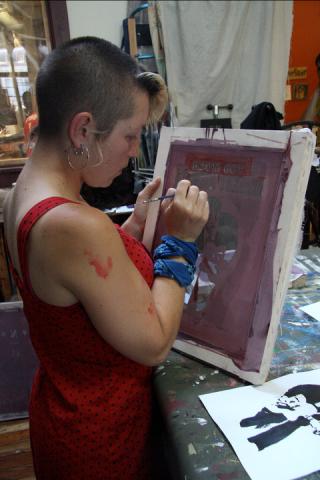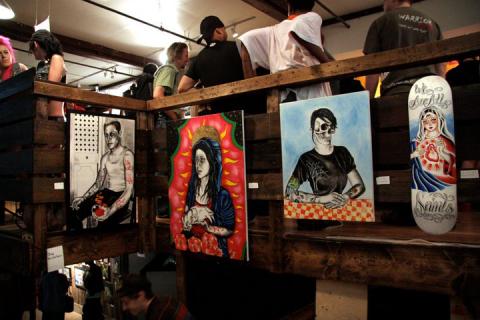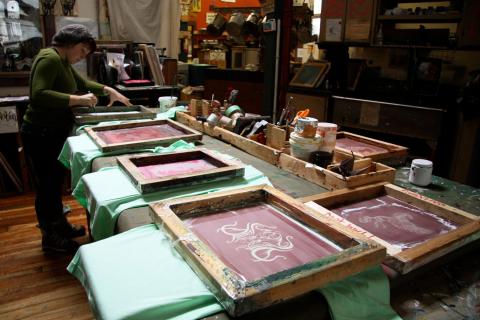
“The underlying assumption behind every welcome or entrance [into Sketch] is that we just assume people are creative and that they have something to contribute,” Novak tells Samaritanmag. “That’s not always something that homeless people or marginalized young people hear. They don’t hear that they have capacities that the rest of the world needs to learn from. They hear that they have deficits and that they need to get those taken care of, and then they can participate as a full member of society.”
One of the central motives behind Sketch is to expand the opportunities for homeless and street-involved youth. It offers the chance for struggling young adults to get relief from the conflicts and pressures of an underprivileged life, and just let loose creatively and become part of a community.
“People first know how to be themselves and feel good about being themselves, and then feel okay about interacting with each other and building cooperation and communication skills with each other,” Novak says of the learning framework after which Sketch is modeled.
“And then the people [start] getting excited about the potential of using the arts to participate in the world, making stuff to show and to sell, or writing a song and performing it in public.”
Beyond its purpose as a centre to foster creativity, Novak insists that the people who use the studio must develop a consciousness for good behaviour and have respect for the rest of the Sketch community.
Novak first worked on broadening the creative horizons of street youth when she worked as the arts coordinator for the Evergreen drop-in centre in the early 1990s. An actor and theatre school graduate herself, Novak says that at Evergreen, arts was used “to help us figure out who we were. Everybody had a strong desire to play more, a strong desire to express themselves and share their stories, a strong desire to share skills with each other, and a strong desire to create community together.”
Upon leaving Evergreen, Novak worked on launching Sketch’s foundation. With some of her co-workers, she began calling organizations asking for grants and funds to help launch a centre for at-risk youth engagement in the arts.

“[We] basically tried to advocate that no matter what your circumstances are, you do have the capacity to see beauty and be a part of creating beauty,” she explains.
To reach the public, she relied on word-of-mouth from a creative campaign that involved screening art at festivals and galleries, as well as a parade through the downtown streets.
The second floor of an old leather factory on King St. became the 6,000 sq. ft. headquarters for hundreds of underprivileged youth every year—Novak estimates that around 800 youth came to Sketch in 2010. By holding several disciplines of art, including drawing, textiles and screen printing, Novak and her staff have given the youth a wide variety of options to tap into their creativity.
“The whole learning framework is a bit of a progressive one, so you’re kind of moving from a place of isolation,” she says. “You suddenly move into this place with community and classes and skill building and skill exchange and figuring out who you are and what you want to learn more of and then go further.”
Novak refers to those who occupy the space as “community artists,” who use personal experiences to communicate their stories to the community via art.
This approach can lead to bigger things for the young artists, Novak says. “Lots of people go on to further education, lots of people go on to work environments. I would say that of our whole contingent in a year, probably a quarter of that is a group of people who will choose the arts as the way of career.”

A few of the instructors who assist Sketch’s artists have even been in the student’s place before and have been taught by other community artists themselves. “It’s not very long before a young person [realizes] that they have a desire to share their skills with each other,” she says.
When the artists get to the stage when they are ready to exhibit their art, many feature their work in galleries while others post their art on the Sketch website. Some artists who share living space can even host a gallery from their house. Their work usually sells for around $100 to $200.
Sketch is currently in the process of moving its main workshop space to an old school on Shaw St. that is being revitalized as a centre for emerging artists. Meanwhile, the young artists are working on programs in different spaces around the Greater Toronto Area.
“We’re building the vision together for the new space,” says Novak. “It’ll have a real sense of everybody’s voice. We don’t just want to pick up and transfer what we have. We want to grow and learn from what we have created and help youth be a part in determining that change.”
adidas Yeezy Boost 350 V2 News, Colorways, Releases